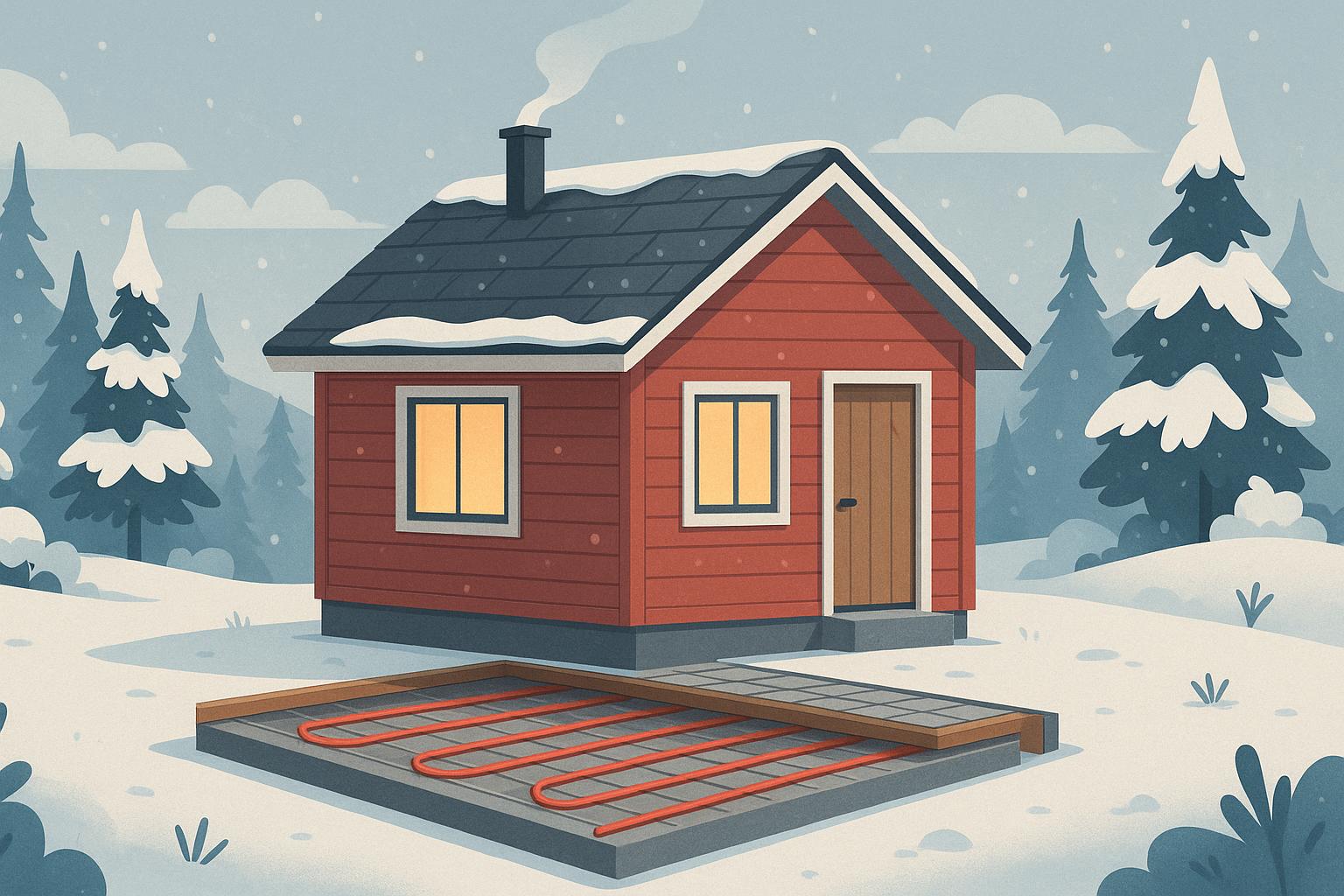
Hydronic Heating Tiny Homes: Efficient Radiant Floors for Canadian Winters
Estimated reading time: 7 minutes
Key Takeaways
- Efficient Heating: Hydronic heating systems provide even, steady warmth in tiny homes.
- Space-Saving Design: Radiant floors are hidden beneath flooring, maximizing living space.
- Energy Efficiency: Lower operating costs and precise temperature control make them ideal for Canadian winters.
- Installation & Maintenance: Though efficient, installation requires specialist skills and careful planning.
Table of contents
Overview of Hydronic Heating Systems: Hydronic Heating, Radiant Floors, Tiny Homes
How Hydronic Heating Works
Hydronic heating uses a simple yet effective idea: heat water, circulate it through pipes, and let the warmth radiate into the space. In tiny homes, the process includes:
- Heated Water Source: A compact boiler or water heater raises the water temperature.
- Pipe Network: Warm water is directed through pipes laid beneath the floor, in walls, or along baseboards.
- Radiant Surfaces: Heat radiates from these surfaces, warming objects, furniture, and people rather than just the air.
This method avoids the uneven heat distribution of forced-air systems, ensuring a gentle and consistent warmth.
Types of Hydronic Heating for Tiny Homes
-
In-floor Radiant Heat
- Flexible tubing is set beneath floor materials, allowing heat to rise evenly.
- Preferred for its invisible design and efficiency in compact spaces.
-
Hydronic Baseboard Heaters
- Hot water circulates through units mounted along the baseboards, ideal where in-floor options are not feasible.
- Maintains good efficiency even in tight installations.
For more details, visit WarmlyYours, Green Building Advisor, and Adustart Tiny Home Living Guide.
Benefits of Hydronic Heating for Tiny Homes: Hydronic Heating, Radiant Floors, Canadian Winters, Energy Efficiency
Energy Efficiency
Hydronic systems are renowned for their energy efficiency because:
- Lower Water Temperatures: They operate at temperatures lower than traditional forced-air systems.
- Reduced Heat Loss: Water transfers heat more efficiently, cutting down on energy waste.
- Precision Control: Zoning capabilities allow for tailored temperature settings in different areas.
Comfort and Consistent Heating
The warmth from radiant floors moves upward, ensuring that every corner, from toes to head, feels evenly heated — a vital benefit during harsh Canadian winters.
Space-Saving Benefits
- No Bulky Ductwork: The absence of large radiators or ducts maximizes living space.
- Discreet Installation: Pipes and tubing remain hidden, allowing for a clean and uncluttered look.
- Ideal for Compact Living: Every square inch is preserved for living, not heating infrastructure.
Learn more at WarmlyYours Canada, Green Building Advisor, Adustart Canada Guide, and Adustart Tiny Homes Space Cost Sustainability.
Challenges and Considerations: Hydronic Heating, Radiant Floors, Tiny Homes, Canadian Winters, Energy Efficiency
Despite the many benefits, there are some challenges to consider when installing hydronic heating in tiny homes:
Initial Installation Costs and Complexity
- Upfront Cost: Radiant floor systems often require a higher initial investment compared to simpler solutions.
- Complex Installation: The routing of piping demands professional expertise to avoid costly mistakes.
Maintenance During Harsh Winters
- Reliability: While robust, these systems need regular maintenance to prevent issues such as frozen pipes.
- Freeze Protection: Ensuring proper winterization is crucial in the Canadian climate.
Space Constraints
- Tight Installations: Limited space in tiny homes requires custom planning of plumbing routes.
- Custom Engineering: Each installation may need a unique design to maximize efficiency without compromising space.
For further insights, check out WarmlyYours Canada, Green Building Advisor, and Adustart Winter Proof Tiny Home Canada.
Cost and Installation Comparison: Hydronic Heating, Tiny Homes, Radiant Floors
Budget Breakdown
- Radiant Floor System (100 sq ft): Estimated material and labour starting at approximately $560 CAD.
- DIY Option: Can lower upfront costs, though it comes with a risk of improper installation.
- Professional Installation: More costly, but ensures proper, reliable setup.
- Operating Costs: Typically lower due to enhanced energy efficiency; for example, around $0.63 per day for a well-insulated 100-square-foot space.
Comparison Table
| System Type | Upfront Cost | Space Used | Energy Cost | Reliability |
|---|---|---|---|---|
| Hydronic Radiant Floor | $$-$$$ | Minimal | $ | High if professionally installed |
| Electric Baseboard | $-$$ | Moderate | $$ | High |
| Propane/Space Heater | $ | Moderate | $$-$$$ | Medium |
Timeline and Complexity
Installation time depends on several factors, including home layout, flooring type, and installer expertise. Professional installations usually finish in a few days, whereas DIY projects might take longer.
For additional information, visit WarmlyYours Canada and Adustart Tiny Home Living Canada Guide.
Energy Efficiency Insights: Hydronic Heating, Energy Efficiency, Tiny Homes, Canadian Winters
Efficiency Mechanisms
- Low-Temperature Water: Radiant floors can effectively warm a room using water temperatures as low as 27°C-38°C.
- Direct Heat Transfer: Water transports heat directly, minimizing energy loss.
- No Duct Losses: Unlike forced-air systems, hydronic heating avoids losses due to air leaks.
Impact of Home Design
A well-insulated, airtight design works hand in hand with hydronic systems, ensuring that heating is efficient and energy is not wasted. Better zoning and fewer air leaks further enhance performance.
For more details, see Green Building Advisor, WarmlyYours Canada, and Adustart Energy Efficiency for Tiny Homes in Canada.
Case Studies/Examples: Hydronic Heating, Tiny Homes, Radiant Floors, Canadian Winters, Energy Efficiency
Canadian Off-Grid Tiny Home
In one Quebec case study, an off-grid tiny home uses hydronic radiant floors to maintain an even temperature despite severe winters. The homeowner noted:
- Even heat distribution with no cold spots.
- Stable interior temperatures even when outdoor conditions drop below zero.
- Lower heating bills after the initial investment period.
Urban Tiny Home with Hydronic Baseboards
An Ontario tiny home employs compact hydronic baseboard heaters that blend seamlessly with the interior design while providing dependable warmth and minimal maintenance.
Hypothetical Remote Northern Tiny Home
Imagine a tiny home north of Thunder Bay facing -40°C temperatures. By combining radiant floor heating for main areas with hydronic baseboard units in smaller zones, and complementing this with robust insulation, the system maintains comfort for under $20 per month in energy costs.
Additional insights can be found at Green Building Advisor, WarmlyYours, and Adustart Tiny Home Living Canada Guide.
Conclusion: Hydronic Heating, Tiny Homes, Radiant Floors, Canadian Winters, Energy Efficiency
Hydronic heating and radiant floor systems offer a compelling solution for tiny homes facing the challenges of Canadian winters. They provide:
- Even, reliable warmth without drafts or cold spots.
- Space efficiency due to their discreet installation.
- Lower operating costs thanks to precise temperature control and reduced heat loss.
- Adaptability for various layouts, from off-grid cabins to urban micro-homes.
Homeowners should consider initial costs and consult professionals to ensure efficient design and installation. For further guidance, visit WarmlyYours Canada, Green Building Advisor, WarmlyYours, Adustart Tiny Home Living Guide, and Adustart Tiny Homes Space Cost Sustainability.
Frequently Asked Questions
What is hydronic heating?
Hydronic heating is a system that uses heated water circulated through pipes to provide gentle, radiant warmth, typically integrated into floors or baseboards.
Is hydronic heating cost effective for tiny homes?
Yes, while the initial installation costs can be higher, the long-term savings in energy efficiency and lower operating costs make it a cost-effective choice for tiny homes.
How do I maintain a hydronic heating system during harsh Canadian winters?
Ensure regular maintenance, proper winterization to prevent pipe freezing, and consider professional assistance for installation and periodic checks to maintain optimal system performance.

Leave a Reply